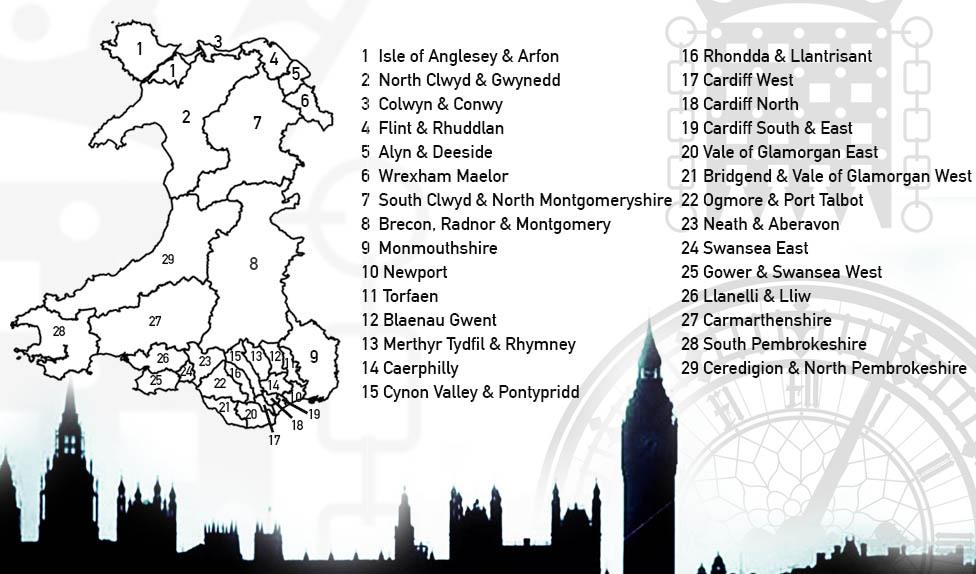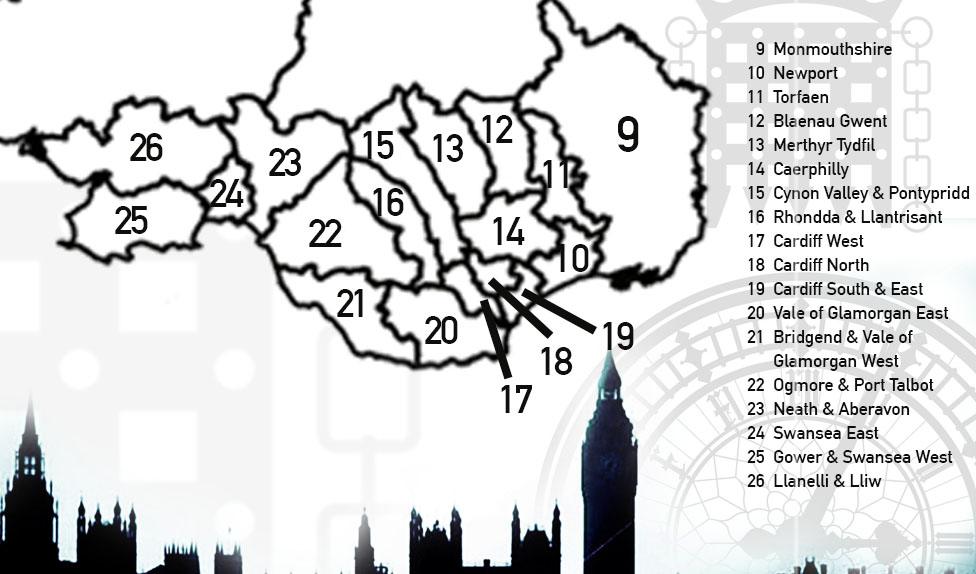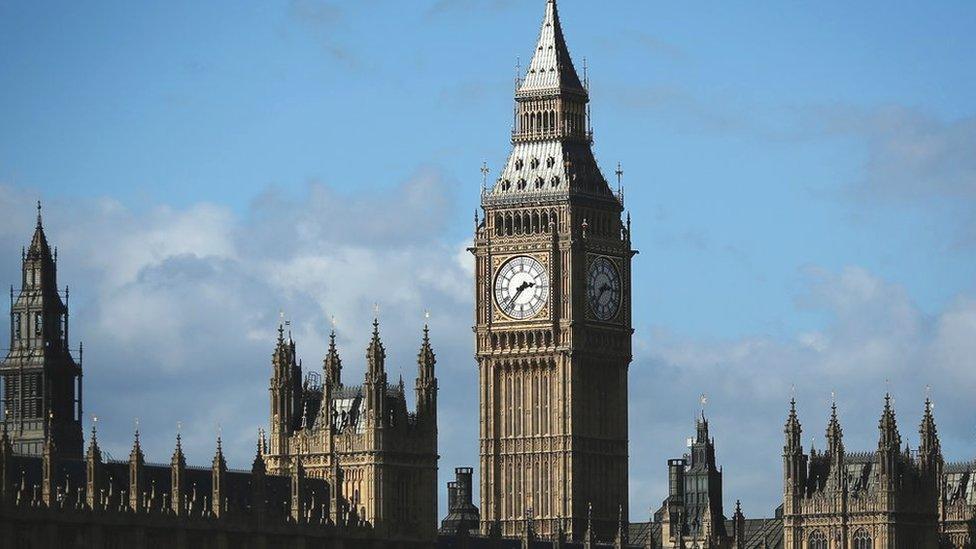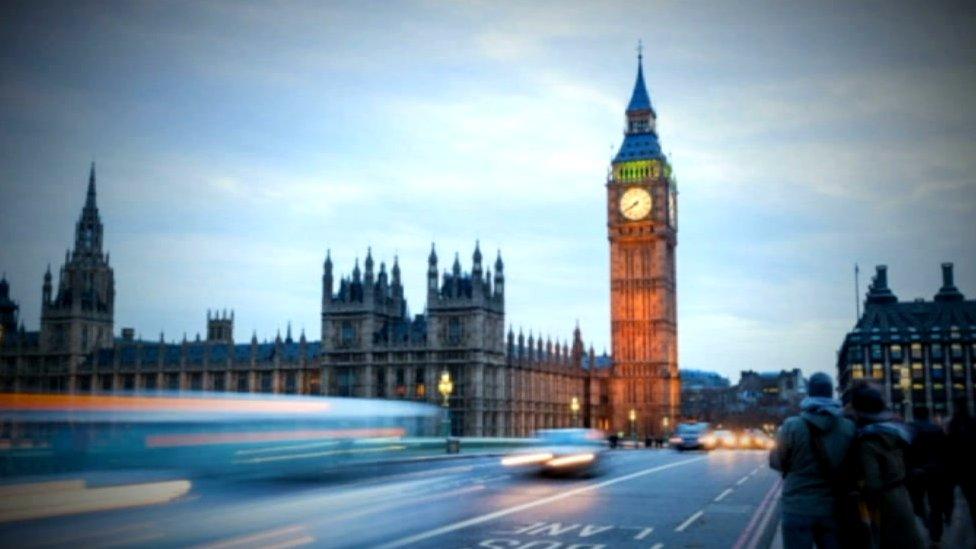Boundary Commission map cuts Welsh MPs by a quarter
- Published

A new Parliamentary map outlining plans to cut the number of Welsh MPs by more than a quarter has been published.
The number of Welsh seats in the House of Commons would fall from 40 to 29, with the size of Westminster constituencies increasing.
Labour - which won 25 Welsh seats at the last election - is likely to feel the biggest impact.
Voters have been invited to have their say during a 12-week consultation, with the final report due in 2018.
The new constituencies have been drawn up by the independent Boundary Commission for Wales under a formula set down under the previous Tory-Lib Dem coalition government.
Constituency boundaries will change across the UK, reducing the size of the Commons from 650 to 600 seats.
But Wales will see the biggest proportional cut among the four nations.
All of the new constituencies must have at least 71,031 voters. At present in Wales, all but one of the existing seats have electorates smaller than that.
People in Bridgend share their views on plans to cut the number of MPs
If introduced in time for the 2020 general election, the review would mean the Commons and the Welsh Assembly no longer share the same constituencies.
The Boundary Commission said it had tried to preserve community links, but did not take political considerations into account.
Steve Halsall, secretary of the Boundary Commission for Wales, said it was an initial set of proposals.
"It has also taken into account other relevant factors and has sought to identify the solutions most suitable to local needs within Wales," he said.
Welsh Labour accused the Conservatives of "trying to stack the deck in their favour" by pushing ahead with the new boundaries.

This map shows the 29 new constituencies proposed

A close-up of the proposed new boundaries in south Wales
The party claimed these did not take into account the millions of extra people who registered to vote in the EU referendum.
Labour MP Stephen Kinnock, whose Aberavon constituency would be split up, called the proposal a "bare-faced gerrymander".
Conservative MP Glyn Davies, whose Montgomeryshire seat would also disappear, said it was "massively disappointing" for him personally but that, in general, the changes were "pretty well inevitable".
He said he was concerned that rural MPs would "lose the familiarity with their constituents" if their seats grow bigger, "bit like MEPs at the moment".
"No matter how hard they work people in my constituency just don't know who they are," Mr Davies said.
"Indeed, assembly members will become the dominant representative."
Boundaries for Welsh Assembly elections will remain as they are now.
Prof Roger Scully thinks both Labour and the Conservatives will lose Welsh MPs
Plaid Cymru's leader at Westminster, Hywel Williams, said Wales "should not disproportionately lose out" in the Parliamentary changes.
"As it stands, Welsh powers are far weaker than those of both Scotland and Northern Ireland," he said.
"Westminster is still responsible for major areas of policy affecting Wales and our nation will have less of a voice if these proposals go through."
Tory peer Lord Hayward, a boundary review expert, said Wales was in effect receiving a double hit at once in terms of its reduction.
"We have an oversized legislature, by any measure," he said. "Both the House of Commons and the House of Lords are too big.
"Wales is hit particularly hard because, whereas Scotland's representation at Westminster was reduced in 2005 when it got its own parliament, Wales did not have any reduction.
"So, in effect, Wales is getting two stages in one go."

New constituencies - proposed
Isle of Anglesey and Arfon
North Clwyd and Gwynedd
Colwyn and Conwy
Flint and Rhuddlan
Alyn and Deeside
Wrexham Maelor
South Clwyd and North Montgomeryshire
Brecon, Radnor and Montgomery
Monmouthshire
Newport
Torfaen
Blaenau Gwent
Merthyr Tydfil and Rhymney
Caerphilly
Cynon Valley and Pontypridd
Rhondda and Llantrisant
Cardiff West
Cardiff North
Cardiff South and East
Vale of Glamorgan East
Bridgend and Vale of Glamorgan West
Ogmore and Port Talbot
Neath and Aberavon
Swansea East
Gower and Swansea West
Llanelli and Lliw
Carmarthenshire
South Pembrokeshire
Ceredigion and North Pembrokeshire

Analysis by BBC Wales political editor Nick Servini
Nick Servini gives his view on plans to redraw Westminster constituency boundaries
This is the first time a review of parliamentary constituencies has called for a cut in the number of Welsh MPs since the Boundary Commission came into existence.
There will inevitably be all sorts of local objections and it is worth remembering that the commission has a track record in altering its initial recommendations substantially.
For example, Penarth is being split from Cardiff South and put in the Vale of Glamorgan, but that means the Vale of Glamorgan has to be split in two.
Penarth goes into a new seat in the east, while a new constituency in the west takes in Bridgend. Just one instance of a major boundary change that will now go out for consultation.
I suspect the response from the public will fall into two camps: those that want to see a cut in the cost of politics and those who will be concerned at the loss of so many Welsh voices at Westminster.
A feature of the proposals is the creation of a number of huge constituencies, particularly in mid Wales.
Inevitably, as the largest party in Wales, Labour has most to lose and its MPs have already based their criticism around the claim that the re-organisation is using out-of-date information.
- Published13 September 2016

- Published8 September 2016
- Published2 March 2016

- Published24 February 2016

- Published14 March 2016

- Published24 February 2016